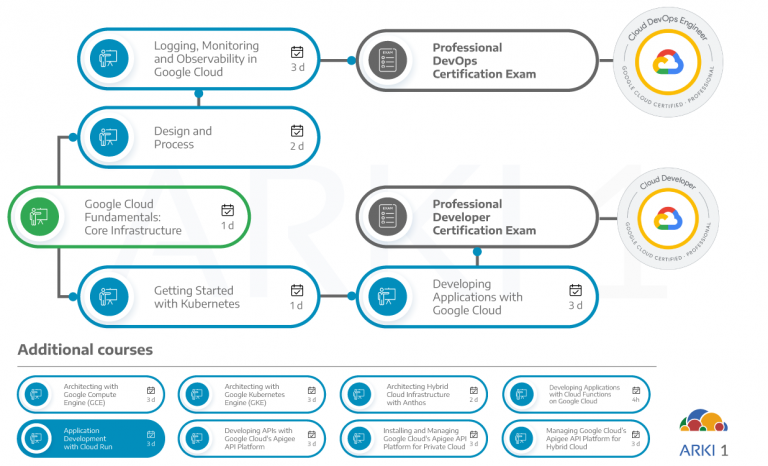Este curso te introduce a los fundamentos, prácticas, capacidades y herramientas para el desarrollo moderno de aplicaciones en la nube con Cloud Run. A través de una combinación de presentaciones, laboratorios prácticos y materiales complementarios, aprenderás cómo desarrollar y desplegar aplicaciones en Google Cloud utilizando Cloud Run.
Esta versión del curso consiste en dos cursos separados que incluyen temas sobre la creación de contenedores y el desarrollo de aplicaciones con Cloud Run. Los cursos son: Developing Containerized Applications on Google Cloud y Developing Applications
with Cloud Run on Google Cloud: Fundamentals.
Objetivos
En este curso, los participantes aprenderán las siguientes habilidades:
- Define contenedores e imágenes de contenedores.
- Construir y empaquetar aplicaciones en imágenes de contenedores.
- Identificar las mejores prácticas utilizadas para crear, probar y asegurar contenedores.
- Comprender los conceptos básicos de Cloud Run y Google Kubernetes Engine.
- Entender los fundamentos de Cloud Run que incluyen el modelo de recursos, el ciclo de vida del contenedor y el escalado automático.
- Desarrollar y probar aplicaciones localmente antes de implementarlas en Cloud Run.
- Utilizar identidad de servicio e IAM con Cloud Run.
- Integrar aplicaciones de Cloud Run con servicios de Google Cloud.
Público
-
Partners y clientes que deseen aprender a utilizar las herramientas y servicios en Google Cloud para construir y ejecutar aplicaciones en contenedores.
Prerequisitos
Para aprovechar al máximo este curso, los participantes deben cumplir con los siguientes criterios:
- Familiaridad con comandos de Linux y la interfaz de línea de comandos.
- Conocimiento de la consola de Google Cloud, gcloud CLI y redes.
- Comprensión básica de lenguajes de programación como Node.js o Python.
- Entendimiento de scripts de shell, HTTP y experiencia con herramientas de cliente HTTP como cURL.
Duración
Inversión
Resumen del curso
- Understand course learning objectives.
- Understand course structure and agenda
- Define containers and container images.
- Build and package applications into container images.
- Understand the use of CI/CD tools to build container images.
- Identify best practices used to create, test, and secure containers.
- Understand Cloud Run and its use in running containerized applications.
- Understand the basics of Google Kubernetes Engine.
- Understand the fundamentals of Cloud Run.
- Identify the states of a container’s lifecycle on Cloud Run.
- Control access to Cloud Run with IAM
- Understand the fundamentals of IAM.
- Use IAM and service accounts with Cloud Run services
- Understand the process and tools used to develop and test Cloud Run applications.
- Manage service deployments and revisions on Cloud Run.
- Integrate Cloud Run with other Google Cloud services.
- Review the topics discussed in the previous modules.


